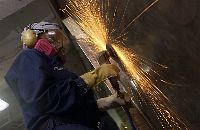
The Source for Navy News
Kitty Hawk Moves into SRA to Maintain Readiness
Story Number: NNS041015-12
Release Date: 10/15/2004 5:21:00 PM
By Journalist Seaman Christopher Koons, USS Kitty Hawk Public Affairs
YOKOSUKA, Japan (NNS) -- USS Kitty Hawk (CV 63) began a Ship’s Restricted Availability (SRA) maintenance period Sept. 16 that will result in many changes for the ship and its crew, and enable the fleet to maintain high levels of readiness under the Navy’s Fleet Response Plan.
Differing from last year’s Dry-docking Ship’s Restricted Availability (DSRA), most of the work will be done on the interior of the ship, said Aviation Ordnanceman 1st Class (AW) John Damiano, maintenance department’s liaison to Ship Repair Facility at Fleet Activities Yokosuka, which will assist Kitty Hawk Sailors during SRA.
“The DSRA was much more extensive because the ship was out of the water. During that time, they completed work on the outside of the ship,” said Damiano. “But during this SRA, we’ll be doing a majority of the work inside the skin of the ship.”
Some of this work will include laying in new polymeric deck coating, said Cmdr. William Jackson, maintenance production control officer for SRA. Other changes, while not as noticeable when complete, are just as important, explained Jackson.
“There is also some significant replacement of ventilation ducting down to the main spaces,” he said. “That’s very noticeable while it’s in progress, but will provide engineers with better access to the ventilation system.”
Kitty Hawk Sailors have experienced some significant changes to their living environment as a result of SRA.
“We’re rehabilitating our berthings, so our Sailors needed to be moved somewhere that offered a decent living environment,” said Chief Aviation Ordnanceman (AW) Richard Leblanc, leading chief petty officer of weapons department's administration office.
According to Kitty Hawk Command Master Chief (AW) Cliff Yager, that meant moving Sailors off the ship and into a temporary lodging facility. Many Sailors have moved out of their living spaces on the ship and onto berthing barges while their normal berthing undergoes the transformation.
The rehabilitation varies from space to space, depending on their individual condition and required repairs. Some berthings were scheduled to undergo minor work, such as receiving a fresh coat of paint, while others were in need of significant repair or replacement of ventilation ducts, water pipes and steam pipes.
“Moving them off the ship gives the Sailors a better living environment,” said Yager. “It moves them out of the industrial environment while the ship is in SRA.”
According to Jackson, the repairs being done to Kitty Hawk’s berthings and lavatories will be worth the short-term displacements, because the changes will upgrade the crew’s living environment aboard the ship.
“After the SRA is over, the berthing and the heads will have been renewed. That will be a significant improvement for the crew,” said Jackson.
Kitty Hawk Sailors have also seen some re-shuffling of the work force in order to accomplish the many tasks during SRA, said Damiano.
“The SRA required many of the crew working for the SRA department,” he said. “It’s almost 300 personnel, working in various teams like decking, lagging and painting.”
All told, there are about 4,800 work orders scheduled for Kitty Hawk during SRA. This continued maintenance enables Kitty Hawk to serve in peak condition under the Navy’s Fleet Response Plan, providing more naval assets as needed throughout the globe.
The Kitty Hawk Strike Group is the largest carrier strike group in the Navy and is composed of the aircraft carrier Kitty Hawk, Carrier Air Wing (CVW) 5, the guided-missile cruisers USS Chancellorsville (CG 62) and USS Cowpens (CG 63), and Destroyer Squadron 15.
For related news, visit the USS Kitty Hawk Strike Group Navy NewsStand page at www.news.navy.mil/local/cv63.
E-mail this story to a friend | Send a comment about this story
Kitty Hawk Introduces Internet Hotspots for Sailors - 10/18/2004Yokosuka Sailors Learn Career Development Skills - 10/15/2004
Kitty Hawk Supply Passes SMI - 9/3/2004
Kitty Hawk Completes Summer Pulse, Returns Home - 9/6/2004
Kitty Hawk Brings Fresh Color to Summer Pulse - 7/28/2004
3M Assessment Pulses Success for Kitty Hawk - 7/27/2004
Kitty Hawk Underway in Support of Summer Pulse '04 - 7/19/2004
|
All Any Exact |
|
